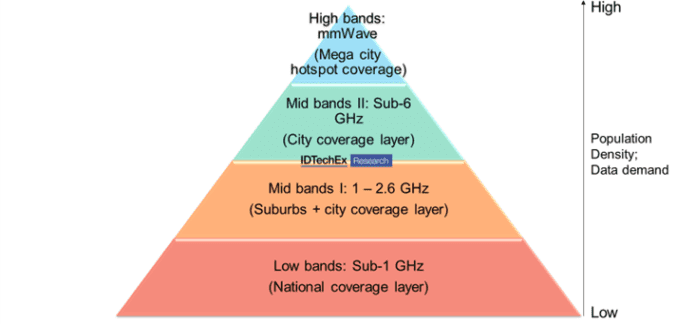5G is paving the way for a fully digitalized and connected world. The past two years have seen many new field trials and an accelerating number of commercial rollouts. Moreover, 5G is starting to be adopted in a wide range of industries, from manufacturing to healthcare. With high throughput and ultralow latency, 5G can tap into many high-value areas including 3D robotic control, virtual reality monitoring, and remote medical control that previous technologies were not able to address. 5G is redefining and accelerating industries such as automotive, entertainment, computing, and manufacturing, and will ultimately change the way people work and live.
IDTechEx has been researching 5G-related topics for many years, and have released their most recent version of the 5G market research report “5G Technology, Market and Forecasts 2022-2032“. This market research and business intelligence report investigates the key technical, industrial, and regional aspects affecting the rapidly expanding 5G market.
Which frequency band is leading: sub-6 GHz or mmWave? What is the deployment outlook in 5 key regions?
5G refers to a set of improved and updated mobile communication technologies, as well as new characteristics arising from new frequency bands: 3.5-7 GHz (also known as sub-6 GHz) or > 24 GHz (also known as mmWave), and larger bandwidths, which is why it can tackle multiple challenges in so many sectors that previous generations could not. According to IDTechEx’s research, 56% of 5G commercial services in the globe operate in the sub-6 GHz range. Almost all the base stations in the sub-6 GHz spectrum are in cities. Figure 1 depicts the network rollout strategy used by telecom operators to build their 5G network, showing that higher frequency bands will be used largely in densely populated regions.
Figure 1: 5G network deployment strategy, from IDTechEx’s “5G Technology, Market and Forecasts 2022-2032” report.
Figure 2: 5G commercial/pre-commercial services by frequency (2021), from IDTechEx’s “5G Technology, Market and Forecasts 2022-2032” report.
Each country/region has its unique release schedule for spectrum. Even though most nations issued the sub-6 GHz spectrum initially, there are few outliers. The US regulatory agency, for example, issued the mmWave spectrum first and only released its sub-6 GHz band in early 2021. As a result, each country’s 5G rollout forecast and deployment strategy will differ. IDTechEx’s “5G Technology, Market and Forecasts 2022-2032” report, includes a detailed regional analysis of 5G deployment status and future rollout roadmap in five key regions: the United States, China, Japan, South Korea, and Europe, including governmental strategy, funding, and key national telecom operators’ 5G rollout schedule and roadmap, as well as revenue analysis.
Two essential technologies for future 5G development: mmWave & Open Radio Access Network (Open RAN)
mmWave, which was previously solely used for military, and satellite, and automotive radar communication purposes, has recently been introduced to the frequency pool for mobile communications, enabling a maximum data throughput of 20 Gbps with an ultralow latency of 1 ms. Such a high frequency necessitates the development of new materials as well as new device designs. Low-loss materials with a minimal dielectric constant and tan loss, for example, as well as advanced packaging solutions, are required for mmWave devices to prevent excessive transmission loss. Because of the short wavelength of mmWave communications, the device is becoming increasingly compact and integrated, making power and thermal management even more critical. In this report, IDTechEx assesses the technical pain points and explores the trends and innovations for both 5G materials and design to overcome these bottlenecks. Furthermore, the report also provides a thorough overview of the 5G mmWave industry, a review of key players, a supply chain analysis, and a look at the vertical applications made possible by mmWave technology
The deployment of 5G infrastructure is critical to enabling widespread 5G adoption. Legacy telecom system vendors such as Huawei, Ericsson, and Nokia hold a large share of the 5G infrastructure market, according to IDTechEx, with Huawei dominating with 36% in 2020, followed by Ericsson with 27%. Telecom operators are pushing Open RAN (i.e. networks based on disaggregated RAN components with standardized interoperability, including the use of non-proprietary white-box hardware, open-source software from different vendors, and open interfaces) development to eliminate the proprietary nature of RAN systems, diversify the vendor supply chain in the telecom industry, bring more innovation, reduce the cost of RAN deployment (remember that 5G deployment cost is more expensive than 4G), and reduce the cost of operation. A few top telecom carriers have already launched small-scaled Open RAN 5G networks as early as mid-2021. Many more have laid out plans to deploy 5G networks in the future using Open RAN technology. How would Open RAN disrupt the 5G infrastructure market and influence the overall supply chain dynamics? Who are the players in the Open RAN field? What would be the potential Open RAN business model? Is Open RAN cheaper than the legacy system? What are the attitudes and strategies of legacy system suppliers concerning Open RAN? What are the remaining challenges of Open RAN? The IDTechEx report discusses all these questions in detail that will help the reader understand the future trend of the 5G infrastructure market.
5G market outlook:
5G market is just about to take off. By the end of 2032, consumer mobile services are anticipated to generate $800 billion in revenue, and 5G macro infrastructure markets will expand seven times larger than in 2020, according to IDTechEx. The forecast builds on the extensive analysis of primary and secondary data, combined with careful consideration of market drivers, constraints, and key player activities. The report provides a historical deployment figure (2019 – 2021) and a ten-year forecast (2022 – 2032) for different segments including the 5G mobile revenue, subscriptions, and infrastructure based on five global regions (US, China, Korea & Japan, Europe, and others), 5G global mobile shipment, 5G global fixed wireless access revenue & customer promised equipment (CPE) shipment, and 5G critical components such as power amplifiers.
For further understanding of the overall 5G markets, players, technologies, opportunities, and challenges, please refer to the IDTechEx report “5G Technology, Market and Forecasts 2022-2032“. In addition, IDTechEx has also authorized several market research reports that cover critical 5G technologies in-depth, including “5G Small Cells 2021-2031: Technologies, Markets, Forecast”, “Low-loss Materials for 5G 2021-2031”, and “Thermal Management for 5G”. For more information on the 5G portfolio from IDTechEx, please visit www.IDTechEx.com/Research/5G.
Help keep news FREE for our readers
Supporting your local community newspaper/online news outlet is crucial now more than ever. If you believe in independent journalism, then consider making a valuable contribution by making a one-time or monthly donation. We operate in rural areas where providing unbiased news can be challenging. Read More About Supporting The West Wales Chronicle


























